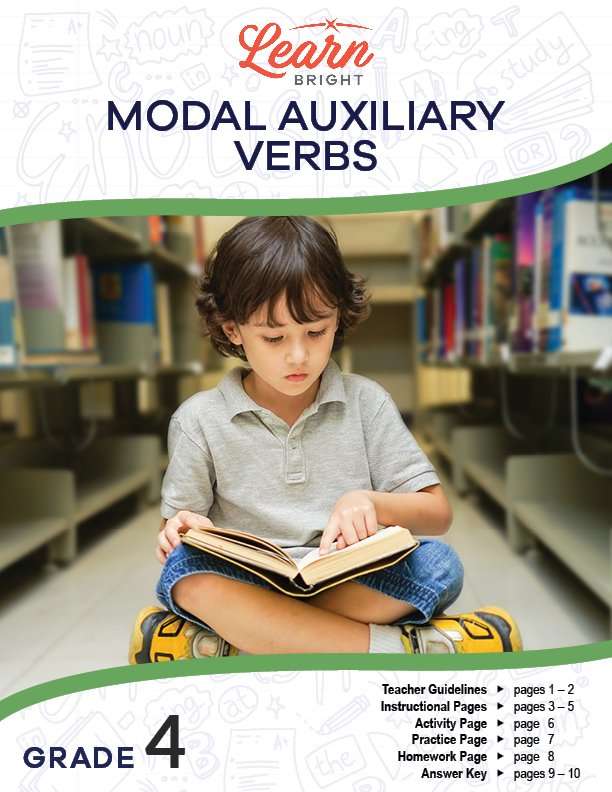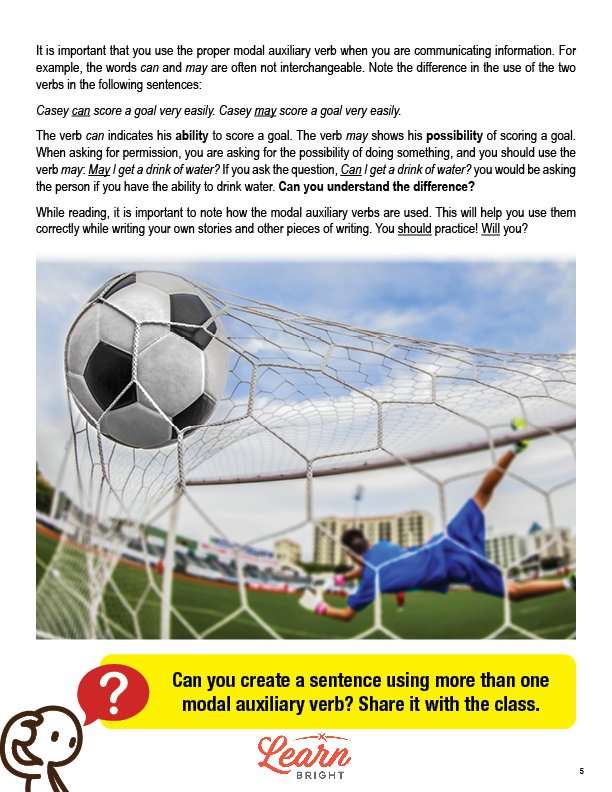Description
What our Modal Auxiliary Verbs lesson plan includes
Lesson Objectives and Overview: Modal Auxiliary Verbs teaches students about modal auxiliary verbs and how to use them in their writing. At the end of the lesson, students will be able to use modal auxiliaries (e.g., can, may, must) to convey various conditions. This lesson is for students in 4th grade.
Classroom Procedure
Every lesson plan provides you with a classroom procedure page that outlines a step-by-step guide to follow. You do not have to follow the guide exactly. The guide helps you organize the lesson and details when to hand out worksheets. It also lists information in the green box that you might find useful. You will find the lesson objectives, state standards, and number of class sessions the lesson should take to complete in this area. In addition, it describes the supplies you will need as well as what and how you need to prepare beforehand. The supplies you will need for this lesson are scissors, containers, and the handouts.
Options for Lesson
Included with this lesson is an “Options for Lesson” section that lists a number of suggestions for activities to add to the lesson or substitutions for the ones already in the lesson. A few of the suggested adjustments are for the lesson activity. For the activity, students can write the sentences on a separate sheet of paper. They can also switch partners once or twice during the activity. For an additional lesson activity, you can have your students write a short story using each of the modal auxiliary verbs at least once. You can also have your students identify the use of modal auxiliary verbs in their current reading or other subject content. Finally, you can conduct a “Modal Auxiliary Verb Bee” where students correct sentences that use modal auxiliary verbs incorrectly by changing the sentence or the verb.
Teacher Notes
The teacher notes page includes a paragraph with additional guidelines and things to think about as you begin to plan your lesson. This page also includes lines that you can use to add your own notes as you’re preparing for this lesson.
MODAL AUXILIARY VERBS LESSON PLAN CONTENT PAGES
What is a Modal Auxiliary Verb?
The Modal Auxiliary Verbs lesson plan includes three content pages. Students have likely already learned about auxiliary verbs, also known as helping verbs. Some examples of helping verbs include have and are. We can use auxiliary verbs as linking verbs alone or with an action verb. They can express time relationships and moods. They can also form the tense and voices of other verbs.
We can use the helping verb is/has as a linking verb, in sentences like: Maria is tall. My friend has a game after school.
We can also use is/has with action verbs: Tony is running home. My mom has arrived home.
Some common auxiliary verbs include be, do, and have verbs. Be verbs include am, is, are, was, were, being, and been. Do verbs include does, do, and did. Have verbs include has, have, had, and having.
Another type of auxiliary verb is the modal auxiliary verb. These don’t change form, and you can’t add an ed, ing, or s ending to them. Modal auxiliary verbs indicate necessity or obligation, possibility, willingness, or ability. They include can, could, may, might, must, ought to, shall, should, will, and would.
Using Modal Auxiliary Verbs
You can use modal auxiliary verbs with action verbs and other helping verbs, just like auxiliary or helping verbs. Modal auxiliary verbs show necessity, obligation, possibility, willingness, or ability. The lesson shows each of these uses with example sentences that show how you can use modal auxiliary verbs.
To show necessity or obligation, you might use a modal auxiliary verb in the following ways: You should wake earlier each day if you do not want to be late for school. You must remember to do your homework each night. Noah ought to be studying more often if he expects to get an A on the test.
To show possibility, you might use a modal auxiliary verb in the following ways: Chloe might visit you on Saturday if she is available. Because he was so hungry, I think Jason could have eaten another whole pizza. The weather forecaster said it may rain tomorrow.
To show willingness or ability, you might use a modal auxiliary verb in the following ways: Sean will mow the lawn this Saturday for a reasonable price. I think you can swim much faster if you practice every day. Kimberly thought she would sing well during the concert at the school, and her mother agreed.
You can use modal auxiliary verbs in certain patterns, including modal + main verb (I may eat a hamburger and some French fries for dinner), modal + be + present verb (You should be studying for the test and not be playing games), and modal + have + past verb (Molly may have completed the work, but there is more to do).
You should make sure you’re using modal auxiliary verbs correctly in your speaking and writing. Can and may, for example, are not always interchangeable. Can indicates ability, while may indicates possibility. This might come up when you’re asking permission for something. You’re asking for the possibility of doing something, so you should use may instead of can.
It’s important to identify modal auxiliary verbs and how they’re used while reading. This will help you improve your own usage of them!
MODAL AUXILIARY VERBS LESSON PLAN WORKSHEETS
The Modal Auxiliary Verbs lesson plan includes three worksheets: an activity worksheet, a practice worksheet, and a homework assignment. You can refer to the guide on the classroom procedure page to determine when to hand out each worksheet.
SENTENCES ACTIVITY WORKSHEET
Students will work with a partner to complete the activity worksheet. Each pair will cut out the sets of modal auxiliary verbs on the worksheet, fold them, and place them in a container. They will then each choose a verb. One partner will correctly use their word in a sentence, and the other partner will respond to that statement using their own word.
Students may also work alone or in groups for the activity.
FILL IN THE BLANKS PRACTICE WORKSHEET
The practice worksheet asks students to complete three short exercises. For the first, they will fill in the blanks in sentences with shall, should, will, or would. For the second, they will fill in the blanks with ought to, can, may, or must. And for the third, they will fill in the blanks with could or might.
MODAL AUXILIARY VERBS HOMEWORK ASSIGNMENT
For the homework assignment, students will write sentences correctly using each of the given auxiliary verbs. They will also circle the best auxiliary verb for each sentence.
Worksheet Answer Keys
This lesson plan includes answer keys for the practice worksheet and the homework assignment. If you choose to administer the lesson pages to your students via PDF, you will need to save a new file that omits these pages. Otherwise, you can simply print out the applicable pages and keep these as reference for yourself when grading assignments.









